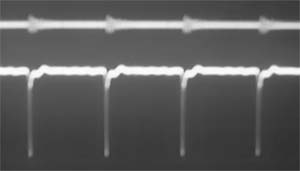Pump Scheme Yields Ultrastable Microchip Laser Performance

By: Yvonne Carts-Powell
Intracavity frequency-doubled microchip lasers are small devices that allow users to generate visible wavelengths. The beam that emerges from a microchip laser, however, tends to contain a lot of amplitude noise. Researchers at laser display startup Laser Vision Technologies (Beaverton, OR) have found an inexpensive method that significantly reduces the amplitude noise in microchip laser beams (see Figure 1).

At some regular interval, the current driving the pump laser is turned off for a few nanoseconds. "The initial experiments consisted of sharply turning the pump laser off then on at a set frequency," said researcher Ed Miesak of Laser Vision. "This had the effect of reducing the optical noise from more than or equal to 30% to less than 1%."
Microchip laser design
Intracavity doubled microchip lasers typically have the solid-state laser gain medium and a second harmonic conversion crystal bonded together (see Figure 2). The ends (along the optical axis) are coated to provide the end mirrors for the laser cavity. To create a blue beam, the researchers are using neodymium-doped yttrium aluminum garnet (Nd:YAG) for the gain material and potassium niobate for second harmonic generation (SHG). To create a green beam, they use neodymium-doped vanadate (Nd:YVO4) for the gain and potassium titanyl phosphate (KTP) for SHG. The noise-reduction method works for both systems.

The rear surface is coated to allow the diode laser pump light to enter, but to reflect all of the solid-state laser light (the fundamental frequency) and all of the second harmonic light. The front surface is coated to reflect all of the fundamental frequency but allow the second harmonic light to pass out of the laser cavity.
The solution to the problem
When all the input into the laser is constant, however, the microchip laser's output amplitude varies, chaotically, over time. Many researchers have presented methods to stabilize the output, but Miesak says, "The solutions tend to deal with the fundamental laser design, can be difficult or expensive to implement, and are usually not easily retrofit-able to an existing laser."
In contrast, Miesak's method requires pulsing the power supply, which can be achieved with inexpensive electronics. The group designed and built a very high frequency response circuit that produces a DC current which is pulsed to zero in very sharp spikes. "We're using a $4 surplus computer power supply, and the most expensive component of the chopper electronics is a $30 FET—the rest of the parts you can pick up at Radio Shack." The researchers have applied for a patent on the method.
The duration of the spikes is as short as possible, in this case, about 20 ns. The frequency at which the spikes occur depends on the dynamic characteristics of the cavity. The researchers have discovered frequencies that work, but haven't optimized the frequency yet.
Miesak explains, "Two conditions are necessary in order to make the laser operate in a quiet mode, the pulsing circuit has to be driving the pump diode and an optimum temperature on the microchip laser is required, which is not necessarily the optimum phase-matching temperature."
How it works…maybe
Why the method works is still unknown, although Miesak offered a guess, "We think we're doing controlled mode-hopping." When all the input is constant, there is some build-up period before the laser reaches an equilibrium state. Once that happens, the most dominant modes in the second-harmonic crystal absorb most of the energy until they are exhausted (aka spatial hole burning) at which point other modes begin to build up. "By switching off the gain, we allow other modes to start building up before the dominant modes are exhausted."
If the spiking frequency is too low, the researchers found that they produce a sinusoidal ripple in the output. At frequencies such as the one shown in Figure 1, the ripple can be used to trigger a lock-in amplifier. Potential applications of the laser with a lock-in amp include coherent detection, which is useful for picking a signal of a specific frequency out of a noisy background.
That is a side-benefit to the researchers at Laser Vision Technologies. They are focused on using these lasers to build inexpensive laser displays. "Our beams don't compare to the $100,000 systems," says Miesak, "but they are very usable."
About the author…
Yvonne Carts-Powell is a freelance science and technology writer based in Belmont, MA.
